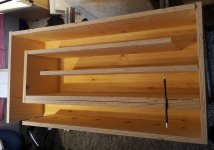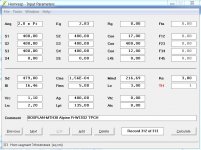I think this would more accurately be modeled as a compound horn(CH) instead of tapped. The summation is going to make it deviate from the model though.
I do not see why simming it as a CH is any better. Hornresp do not really care about the exact definition of "tapped" : It just indicates that both pipes share the same "node" (in akabak terms ) at their end. The fact is that both resonators share the same mouth, it does have an effect on the fr ( making it less damped ). Simming it as a CH accounts for LESS and would be in that case worse. You can check that by using akabak ( I cannot seem to get it working right now ).
@Brian Steele:
You did not seem to like the deep notch a few years back when I mention the same distortion lowering effect of a deep suckout above the passband.
The distortion reduction effect I'm talking about has nothing to do with leaving a notch/suckout above the passband, which can cause integration issues with any speakers handling the rest of the spectrum. Entirely the opposite, in fact, as the purpose of using an offset in a TL is to **eliminate** that notch. It appears to be the offset that helps to reduce distortion.
what is this sacrilege? This is not tapped, it's a TL on both sides.
Looks like a tapped pipe to me. A compound horn is a parallel tuned BP6. A tapped horn (positive, straight, or negative flare) is a series tuned BP6.
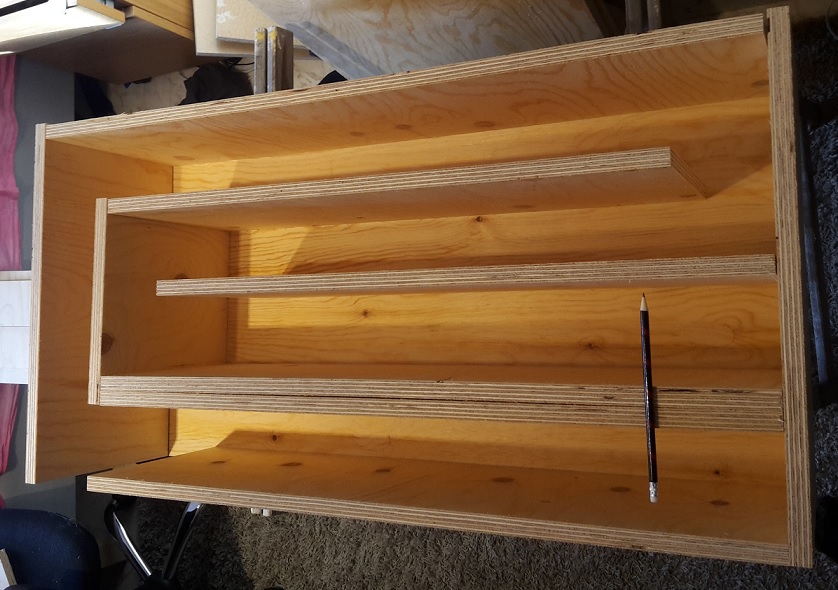
The driver should be under the pencil in the picture.
This is just an example to show a simple to build layout.
 Can we have the dimensions, I'd like to draw this up, maybe make some wagers for fake internet points.
Can we have the dimensions, I'd like to draw this up, maybe make some wagers for fake internet points. Do you plan on installing that last segment like that or are you just trolling us?
Attachments
Based on 1.905cm(0.75") wood.
17cm +400cm +12cm +135cm +(1.905cm × 4 sections) = 571.62cm internally.
571.62cm / 4 sections = 142.905cm wide internally based on the current picture.
17cm x 2 speaker halves = 34cm speaker outer diameter and possible enclosure internal depth.
400cm2 cross section / 34cm depth = 11.76cm height.
11.76cm height x 4 sections + (1.905cm x 3 internal panels) = 52.77cm enclosure internal height.
External width = 142.905cm + (1.905cm x 2 panels) = 146.715cm or 57.76".
External depth = 34cm + (1.905cm x 2 panels) = 37.81cm or 14.89".
External height = 52.77cm + (1.905cm x 2 panels) = 61.57cm or 24.24".
I did all these calculations on my CELL!
17cm +400cm +12cm +135cm +(1.905cm × 4 sections) = 571.62cm internally.
571.62cm / 4 sections = 142.905cm wide internally based on the current picture.
17cm x 2 speaker halves = 34cm speaker outer diameter and possible enclosure internal depth.
400cm2 cross section / 34cm depth = 11.76cm height.
11.76cm height x 4 sections + (1.905cm x 3 internal panels) = 52.77cm enclosure internal height.
External width = 142.905cm + (1.905cm x 2 panels) = 146.715cm or 57.76".
External depth = 34cm + (1.905cm x 2 panels) = 37.81cm or 14.89".
External height = 52.77cm + (1.905cm x 2 panels) = 61.57cm or 24.24".
I did all these calculations on my CELL!
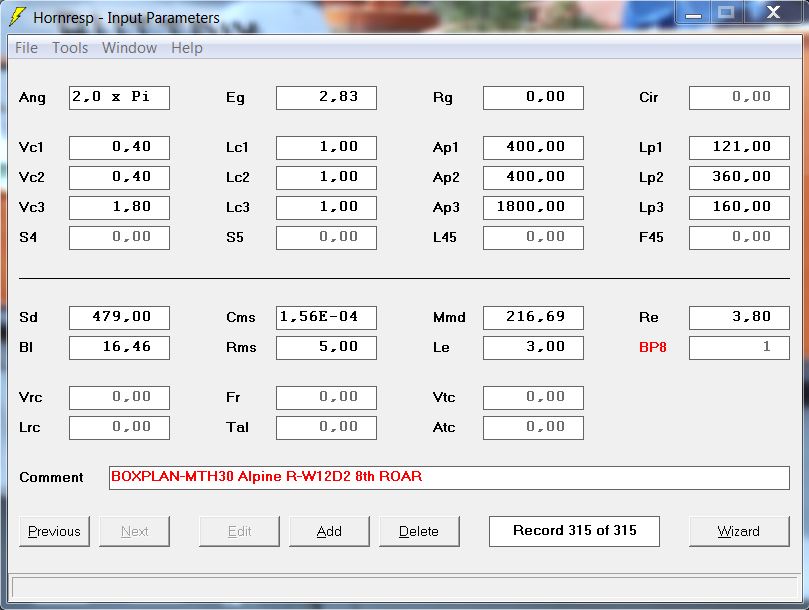
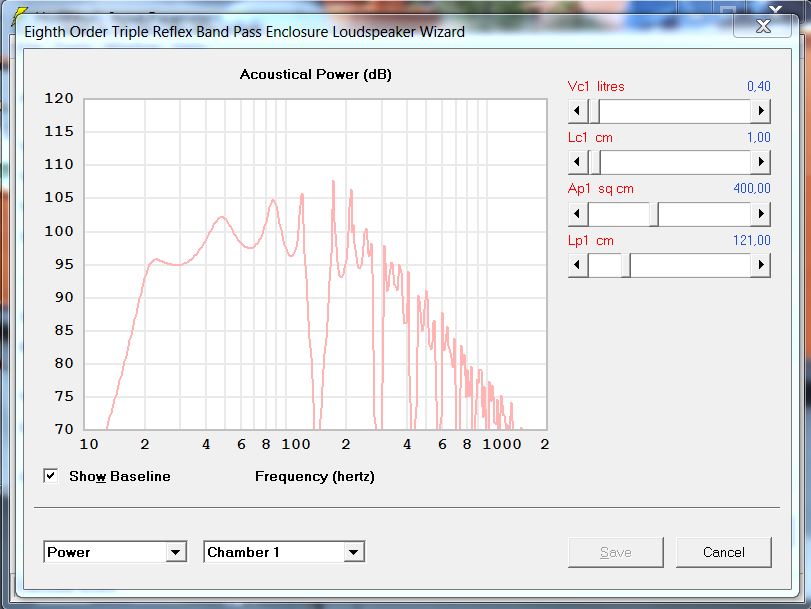
If you want even more usable bandwidth.
It is a CH feeding a large front resonator. It gets quite large, but I do like the efficiency and large bandwidth.
I consider this to be a tapped horn, since both CH resonators couple together in the large front resonator, but I would agree that this might start to push the boundaries of the definition of a "tapped horn".
That won't work, the driver has 162mm mounting depth.400cm2 cross section / 34cm depth = 11.76cm height.
11.76+3.81= 15.57
400cm²/32cm= 12.5
12.5+3.81= 16.31 depth, this a bit tight, the probability of extra crispy voice coil goes up 200%
You'll probably need to cut away portions of the trim ring to shrink the width, while you are at it notch the sides of the box and make a clearance grove behind the pole vent to let it breathe.
Can we have the dimensions, I'd like to draw this up,
Do you plan on installing that last segment like that or are you just trolling us?
This is only a dry-mount of the parts. My son built that box last year.
It was built with a Alpine SWR8D2, so this box is a lot smaller then the simulation I posted previous in this thread.
TPCH with an Alpine SWR8D2
No trolling. It works perfectly. We hit 134,9 dB in our Hyundai Getz in a dB comp, but we built it for the sound quality.
The midbass peak does not sound like a large peak. I adds a nice percussive punch and attack to the character of the bass, without effecting the tonal balance. You can barely hear the peak while sweeping a sinewave with the box outdoors. Indoors the peak drowns totally in the room acoustics.
400cm²/32cm= 12.5
12.5+3.81= 16.31 depth, this a bit tight, the probability of extra crispy voice coil goes up 200%
Or add a much needed third piece of plywood to the baffle.
Here is another build we did last summer:
An externally hosted image should be here but it was not working when we last tested it.
This was built to play loud in a car. 144 dB with 3500 watts at 29 Hz is quite uncomfortable...
An externally hosted image should be here but it was not working when we last tested it.
Measurement in the car vs simulation.
Last edited:
Thank you for the pic and the measurement.
The round opening on top of the enclosure - is it a service port and will be closed when the speaker is in use ? (I assume yes)
Did you calibrate the SPL in the charts? Are we looking at losses in SPL here or is it simply not aligned on the y-axis?
The round opening on top of the enclosure - is it a service port and will be closed when the speaker is in use ? (I assume yes)
Did you calibrate the SPL in the charts? Are we looking at losses in SPL here or is it simply not aligned on the y-axis?
The round opening on top of the enclosure - is it a service port
It is a service port and it is normally closed. I took the picture while the port was open to let some light in onto the driver.
I have not calibrated the SPL. I made the measurement only to verify the basic function of the enclosure. I don't even have a reliable set of driver parameters. Only Fs, Vas, Sd and Qts. The rest i only guestimates.
That won't work, the driver has 162mm mounting depth.
11.76+3.81= 15.57
400cm²/32cm= 12.5
12.5+3.81= 16.31 depth, this a bit tight, the probability of extra crispy voice coil goes up 200%
You'll probably need to cut away portions of the trim ring to shrink the width, while you are at it notch the sides of the box and make a clearance grove behind the pole vent to let it breathe.
I did say "POSSIBLE enclosure internal depth!"
Speaker mounting depth was not known.
I @$$-U-med the mounting depth was factored into the 400cm2.
- Home
- Loudspeakers
- Subwoofers
- Collaborative Tapped horn project
